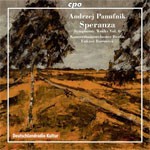Orchesterbesetzung
3.2.2.bcl.2.dbn-4.3.3.1-timp-hpd-strings
Abkürzungsverzeichnis (PDF)
Verlag:
Boosey & Hawkes
Vertriebsgebiet
Dieses Werk ist erhältlich bei Boosey & Hawkes
in der ganzen Welt.
Verfügbarkeit
Uraufführung
25/02/1987
Royal Festival Hall, London
BBC Symphony Orchestra / Andrzej Panufnik
Anmerkungen des Komponisten
Themen
Empfohlene Aufnahme

Konzerthausorchester Berlin/Lukasz Borowicz
CPO 777 685-2
Links
